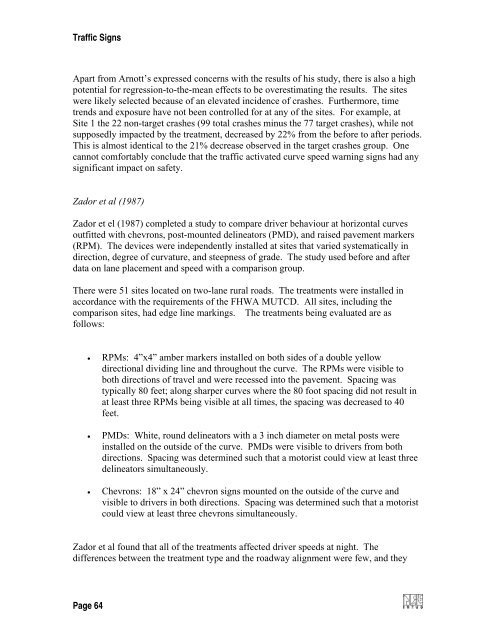Synthesis of Safety for Traffic Operations - Transports Canada
Synthesis of Safety for Traffic Operations - Transports Canada
Synthesis of Safety for Traffic Operations - Transports Canada
Create successful ePaper yourself
Turn your PDF publications into a flip-book with our unique Google optimized e-Paper software.
<strong>Traffic</strong> Signs<br />
Apart from Arnott’s expressed concerns with the results <strong>of</strong> his study, there is also a high<br />
potential <strong>for</strong> regression-to-the-mean effects to be overestimating the results. The sites<br />
were likely selected because <strong>of</strong> an elevated incidence <strong>of</strong> crashes. Furthermore, time<br />
trends and exposure have not been controlled <strong>for</strong> at any <strong>of</strong> the sites. For example, at<br />
Site 1 the 22 non-target crashes (99 total crashes minus the 77 target crashes), while not<br />
supposedly impacted by the treatment, decreased by 22% from the be<strong>for</strong>e to after periods.<br />
This is almost identical to the 21% decrease observed in the target crashes group. One<br />
cannot com<strong>for</strong>tably conclude that the traffic activated curve speed warning signs had any<br />
significant impact on safety.<br />
Zador et al (1987)<br />
Zador et el (1987) completed a study to compare driver behaviour at horizontal curves<br />
outfitted with chevrons, post-mounted delineators (PMD), and raised pavement markers<br />
(RPM). The devices were independently installed at sites that varied systematically in<br />
direction, degree <strong>of</strong> curvature, and steepness <strong>of</strong> grade. The study used be<strong>for</strong>e and after<br />
data on lane placement and speed with a comparison group.<br />
There were 51 sites located on two-lane rural roads. The treatments were installed in<br />
accordance with the requirements <strong>of</strong> the FHWA MUTCD. All sites, including the<br />
comparison sites, had edge line markings. The treatments being evaluated are as<br />
follows:<br />
• RPMs: 4”x4” amber markers installed on both sides <strong>of</strong> a double yellow<br />
directional dividing line and throughout the curve. The RPMs were visible to<br />
both directions <strong>of</strong> travel and were recessed into the pavement. Spacing was<br />
typically 80 feet; along sharper curves where the 80 foot spacing did not result in<br />
at least three RPMs being visible at all times, the spacing was decreased to 40<br />
feet.<br />
• PMDs: White, round delineators with a 3 inch diameter on metal posts were<br />
installed on the outside <strong>of</strong> the curve. PMDs were visible to drivers from both<br />
directions. Spacing was determined such that a motorist could view at least three<br />
delineators simultaneously.<br />
• Chevrons: 18” x 24” chevron signs mounted on the outside <strong>of</strong> the curve and<br />
visible to drivers in both directions. Spacing was determined such that a motorist<br />
could view at least three chevrons simultaneously.<br />
Zador et al found that all <strong>of</strong> the treatments affected driver speeds at night. The<br />
differences between the treatment type and the roadway alignment were few, and they<br />
Page 64
















